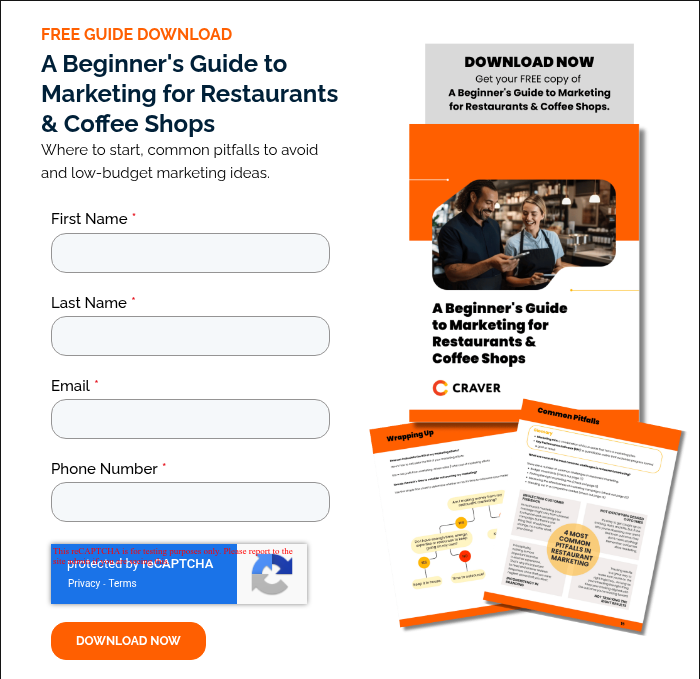Why Do Restaurants Fail? 4 Reasons for Failure (and How to Avoid It)
No matter how long you’ve owned or operated a restaurant, one thing that never gets easier:
The prospect of having to close your doors for good.
Over the past few years, restaurant failure has been a very real concern for the industry. Stock shortages and government-mandated closures forced even the most successful restaurateurs to ask, “Can we afford to stay open?” — and not everyone said “yes.”
Now, in 2024, operators have alleviated some of their pandemic-induced pains and the industry is starting to bounce back.
But that doesn’t mean restaurants aren’t still at risk.
In this blog, we’ll tackle everything you need to know about restaurant failure, including:
- How many restaurants actually fail
- Four reasons restaurants fail (and how to avoid them)
- How Craver can help you reduce your restaurant’s risk of failure
Ready? Let’s get started.
How Many Restaurants Actually Fail?
At some point in your career, you’ve likely heard the first-year failure rate of restaurants is 90%.
It’s a shocking statistic, isn’t it?
That’s because it’s not real.
In 2003, American Express shot a commercial with chef Rocco Dispirito, highlighting the difficulties of owning a restaurant (and how an AMEX business card is the solution, of course).
One of DiSpirito’s lines, in particular, would leave a lasting impact on the restaurant industry for decades: “It’s no wonder that about 90% of all restaurants fail in the first year.”
Public opinion suggests DiSpirito’s statistic was fabricated by AMEX’s advertising and marketing department, and it’s since been disproven multiple times over.
However, while we know with certainty that a 9 in 10 failure rate is wrong…
We don’t necessarily know what failure rate is correct. That’s because the restaurant industry has seen a range of (lower-than-90%) estimations over the past two decades.
- In 2005, an Ohio State University study said 60% of restaurants fail within the first year
- In 2009, the National Restaurant Association said 30% of restaurants fail within the first year
- In 2014, a UC Berkeley study said 17% of restaurants fail within the first year

If we average out those studies, that means ~35% of restaurants fail within the first year of business — almost one-third less than AMEX made us out to believe all those years ago.
Don't be part of that statistic. Grow your sales by up to 40% with a Craver app.
4 Reasons Why Restaurants Fail (and Solutions to Help)
The industry’s 35% failure rate is a good metric to have in your back pocket, but it doesn’t give much detail about why those failures happen.
Because, in reality, restaurants don’t just fail out of the blue.
They fail because different factors — and/or combinations of these factors — negatively impact the restaurant over time, eventually rendering it unsustainable or impossible to run.
So, to illustrate what those factors can look like, here are the top 4 reasons restaurants fail.
(Plus, warning signs to look out for and what you can do before your doors close for good).
1. Restaurant Decisions Aren’t Informed by Data
You’ve probably heard the phrase “knowledge is power” before… and that’s because it’s true.
Customer data is one of a restaurant’s most powerful assets, offering you information on every part of your customer’s experience from how frequently they visit to how they take their coffee.
That data can then inform your decision on just about everything. For example, if your data shows that customers order one protein more than others, you can use that to inform what goes into your next new dish. Or, if your customers visit more at one time of day than another, you can use that to inform when (and how) you try out dynamic pricing.
Despite the clear benefit of data-based decision-making — like the 126% increase in profit and 132% increase in ROI — many restaurants aren’t letting the data do the talking. And, according to William Wilson, CEO of Bloom Intelligence, using customer data is how you keep growing and improving your restaurant (while keeping it open).
“The most advanced operators understand that guest data is their lifeblood,” says Wilson. “[They know] that it should be used not only for marketing, not only for operations but for improvement across the entire operation.”
Solution:
Reframe your perspective on customer data to see it as the “lifeblood” it is. Look at analytics on your restaurant’s mobile app and ordering platforms, explore your guests’ preferences and behaviors, and see how you can better meet their needs — their data shows what they want!
2. The Restaurant Area is Low Traffic or Inaccessible
Your restaurant might have the best food, the coolest ambiance, and the most attentive customer service. But, if nobody shows up, then none of that matters.
For restaurants in low-traffic or hard-to-get-to areas, a lack of customers is a very real concern, because no customers means no money… and no money means no restaurant.
Moving locations isn’t the solution, either.
A 2019 study found that American customers are only willing to travel ~3 miles to eat at a restaurant. What’s more, 62% of restaurant customers use Google to look for restaurants, a search option that typically sorts by distance from where the user is currently.
So, if a restaurant owner struggling with visitorship can’t just move and solve the problem… then they need to get more creative (and more online) to stay open.
“If people don’t see you [online] right away, then they assume there’s [an] issue and they go on scrolling,” says an Area Manager in TouchBistro’s “State of Restaurants” report. Heberto Portobanco, owner of Portobanco’s Restaurant, adds that “social media has been helpful in bringing new guests in,” too.

Solution:
Get online and show what you’ve got! Offer loyalty benefits that incentivize customers to go the extra mile (literally), show up authentically on social media to engage with your audience, and set up online ordering/delivery so people can eat at your restaurant without travelling any miles.
Repeat customers order 1.5x more through a Craver app.
3. Everything is More Expensive for Restaurants
Sometimes restaurants fail for reasons outside their control, like the rising costs of just about everything a restaurant needs to run.
Last year, 58% of operators cited rising inventory costs as their “number one source of financial strain,” followed by labor costs at 20% and rent at 17%. Inventory costs are increasingly damaging in expensive cities like New York City, where even more operators (69%) cite inventory costs as rising concerns.
“We do fresh pasta here in the restaurant, and I used to buy that for $17.85 in 2019,” says David Brugnoli, Owner and Chef at Angeletto, NYC. “Now, I'm paying $42.95 for a 25-pound bag of the same product [and] quality. Plus, we’ve had problems finding the products.”
In many ways, affordability is one of the less “fixable” reasons for failure; the cost of running a restaurant is largely out of owners’ control.
But, that doesn’t mean you have to just sit back and fall victim to the dollar sign.
In TouchBistro’s 2024 report, an Area Manager from Chicago says “[automation] has not only saved money, but [has] also made [their restaurant more efficient].” Another Area Manager notes they’ve found two ways to increase profits: “One is to raise menu prices. The other way is to try and order smarter and reduce waste whenever possible.”
Solution:
Restaurant tech can help you reduce costs in areas you can control to lessen the impact from the areas you can’t. Inventory management tools, for example, can optimize your ordering and reduce waste while online ordering and apps can alleviate the need for front-counter staffing.

4. Restaurant Retention Rates are Too Low
Whether your attractive storefront entices passersby or you’ve gone viral on social media, attracting guests to your restaurant isn’t always a problem — getting them to stick around is.
Customer retention (and the repeat business returning customers generate) is a vital part of any restaurant’s success. Not only does it cost 5-6x less to retain an existing customer than acquire a new one, but repeat customers often spend more per order, too.
But getting customers to come back (and come back often) isn’t that simple.
In 2023, 56% of operators said customer retention posed a significant challenge for their business. Combine that with the industry’s average retention rate of only 30% with diners’ reasons for not returning to a restaurant, and you’ll see why operators have had to get creative with incentivizing repeat visits through offerings like loyalty programs.
“[Loyalty] programs remain one of the best ways to drive repeat visits,” with more and more restaurants and cafes jumping on the opportunity for stronger retention. 85% of bistros and cafes developed loyalty programs in 2023 (up 33% from 2022), reflecting an industry-wide, loyalty-focused shift… and one that seems to be working.
Solution:
Give people a reason to come back with loyalty and/or membership programs. By consistently offering your most loyal customers rewards, discounts, and benefits, you’re showing your diners how much you value them while proving it’s worth it for them to come back again (and again).
How Restaurant Tech Can Help
Every restaurant struggles with its own challenges, whether that’s not using customer data enough or grappling with ever-increasing food prices.
But, no matter your restaurant’s pain points, all of our solutions have one thing in common:
They leverage the incredible capabilities of restaurant tech like Craver’s.
- If you need to amp up how you’re using customer data for decision-making… Craver's platform collects and displays all kinds of behavioral data, from what your customers are ordering to when they visit most frequently, so you can cater your services to what they want (plus, you’ll own the data, too!).
- If you need to find ways to combat low foot traffic or a less-than-ideal location… our mobile app and online ordering platform open up ordering capabilities for customers who may be a little farther away. You can also offer delivery through your Craver app, using your own delivery drivers or our third-party, commission-free delivery integrations.
- If you need to get creative with savings to offset high operational costs… all of our solutions integrate with the systems you’re already using (or want to use!) in a way that saves you time, effort, and money. Choose from integrations like Square, Toast, Stripe, DoorDash, Uber Eats, Relay, and more!
Sure, 35% of restaurants fail within the first year.
But yours doesn’t have to be part of that statistic.
Turn repeat orders from a rarity into an everyday occurrence with Craver.

.png?width=86&name=Untitled%20design%20(84).png)


.png)


